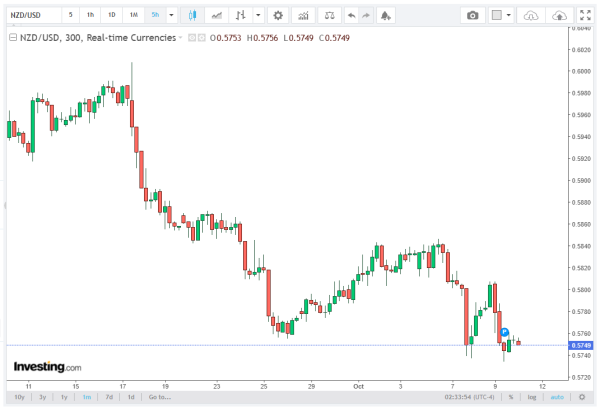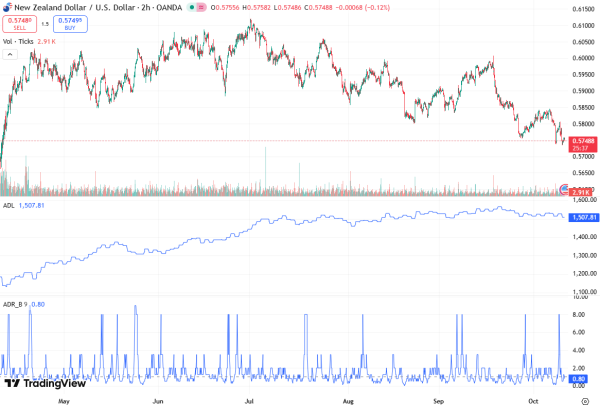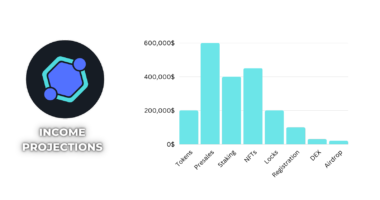The NZD/USD currency pair remains weaker for the fourth consecutive session, trading around 0.5750 during Asian trading hours on Friday. The pair is facing continued downside pressure after the release of September’s Business NZ Performance of Manufacturing Index (PMI), which held steady at 49.9, indicating contraction in the manufacturing sector. The brokers at Solancie provide a comprehensive breakdown of this topic in this article.
The subdued PMI reading underscores ongoing economic challenges in New Zealand, suggesting that growth momentum remains muted. This data comes amid a broader backdrop of monetary policy easing by the Reserve Bank of New Zealand (RBNZ), which has contributed to NZD depreciation against the US Dollar (USD).
RBNZ Rate Cuts Weigh on NZD
The New Zealand Dollar has struggled following the RBNZ’s surprise 50 basis points (bps) rate cut on Wednesday, bringing the Official Cash Rate (OCR) to 2.50%, its lowest level since July 2022. This move exceeded market expectations, which had anticipated a 25 bps reduction, and highlights the central bank’s dovish stance amid concerns about slowing economic activity.
Market participants now widely expect an additional 25 bps rate cut in November, further weighing on NZD sentiment. The RBNZ’s policy outlook signals a continued willingness to ease monetary conditions, aiming to support domestic growth while confronting persistent inflationary pressures.
The dovish outlook has contributed to a bearish bias in the NZD/USD, with traders increasingly factoring in further monetary easing in the near term. Technical levels suggest that 0.5750 remains a key support, and failure to hold this level could open the way toward 0.5700.
US Dollar Strength Amid Risk Aversion
Meanwhile, the USD continues to benefit from safe-haven flows, supported by rising risk aversion due to the ongoing US government shutdown. The US Senate remains deadlocked over legislation to end the shutdown, creating uncertainty in financial markets.
Such political gridlock has historically driven investors toward the US Dollar, boosting its appeal as a global reserve currency. As a result, NZD/USD faces additional downward pressure despite New Zealand’s economic data.
The broader market context suggests that any escalation in risk aversion could reinforce USD strength, potentially limiting NZD/USD upside in the near term. Traders will closely monitor developments in Washington for clues on the duration of the shutdown and its potential impact on US economic growth.

US Monetary Policy Adds Complexity
Although the USD is receiving support from risk-off sentiment, there are also dovish signals from the US Federal Reserve (Fed) that could partially offset USD gains. Fed Bank of San Francisco President Mary Daly noted on Thursday that inflation data has come in lower than expected, signaling a potential softening in the Fed’s tightening bias.
Daly indicated that the Fed is projecting additional cuts in risk management, reinforcing a moderately accommodative stance.
Similarly, Fed Governor Michael Barr highlighted the challenges of interpreting current monetary conditions amid the ongoing government shutdown. Barr acknowledged that the September rate cut was appropriate and that the current policy rate remains modestly restrictive.
However, he cautioned that it is difficult to judge whether the shutdown will have lasting economic impacts, introducing an element of uncertainty for currency markets.

Technical and Market Implications
From a technical perspective, the NZD/USD remains subdued around 0.5750, facing immediate resistance near 0.5780–0.5800. A sustained break below 0.5750 could target 0.5700, while any rebound above 0.5800 might be capped by USD strength and RBNZ dovishness.
The market sentiment remains dominated by risk aversion, with traders carefully monitoring macro data, central bank commentary, and political developments in the US. Short-term volatility could persist as FX markets weigh the impact of RBNZ policy, US economic signals, and the ongoing government shutdown.
Outlook for NZD/USD
Looking ahead, NZD/USD is likely to remain range-bound near current levels unless there is a significant shift in either US or New Zealand economic data. Traders will be closely watching the next RBNZ meeting and the potential for a 25 basis point rate cut, as well as developments surrounding the US government shutdown resolution.
US inflation and broader economic data will also be critical, as they could influence expectations around Fed policy. Additionally, global risk sentiment will play a key role, potentially affecting USD safe-haven flows and overall market positioning.
Overall, NZD/USD faces a challenging environment, with dovish New Zealand monetary policy and USD strength amid risk aversion dominating near-term trends. However, the Fed’s dovish signals and softening inflation in the US may provide temporary support for the NZD, creating trading opportunities around technical key levels.









